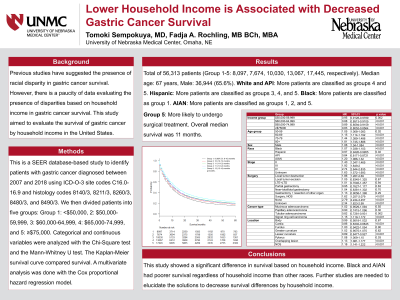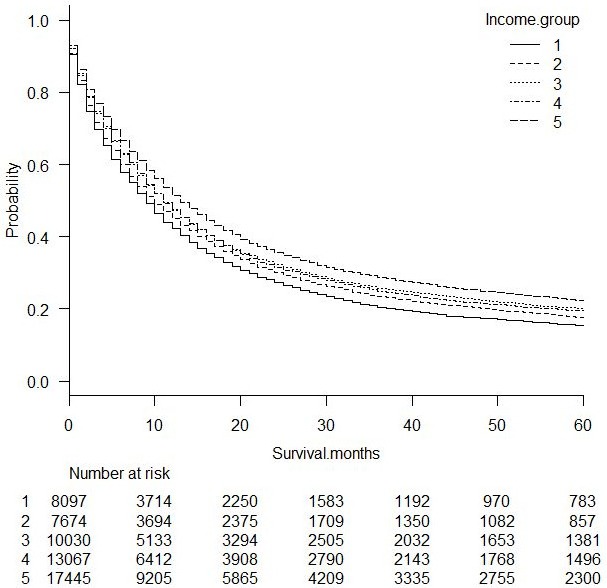Back


Poster Session E - Tuesday Afternoon
Category: Stomach
E0688 - Lower Household Income Is Associated With Decreased Gastric Cancer Survival
Tuesday, October 25, 2022
3:00 PM – 5:00 PM ET
Location: Crown Ballroom

Has Audio

Tomoki Sempokuya, MD
University of Nebraska Medical Center
Omaha, NE
Presenting Author(s)
Tomoki Sempokuya, MD1, Robert J. Pattison, MD2, Fedja Rochling, MBBCh1
1University of Nebraska Medical Center, Omaha, NE; 2Sunrise Consortium GME, HCA Healthcare, Las Vegas, NV
Introduction: Previous studies have suggested the presence of racial disparity in gastric cancer survival. However, there is a paucity of data evaluating the presence of disparities based on household income in gastric cancer survival. This study aimed to evaluate the survival of gastric cancer by household income in the United States.
Methods: This is a SEER database-based study to identify patients with gastric cancer diagnosed between 2007 and 2018 using ICD-O-3 site codes C16.0-16.9 and histology codes 8140/3, 8211/3, 8260/3, 8480/3, and 8490/3. We then divided patients into five groups based on household income: Group 1: < $50,000, 2: $50,000-59,999, 3: $60,000-64,999, 4: $65,000-74,999, and 5: ≥$75,000. Categorical and continuous variables were analyzed with the Chi-Square test and the Mann-Whitney U test. The Kaplan-Meier survival curve compared survival. A multivariate analysis was done with the Cox proportional hazard regression model.
Results: We identified 56,313 (Group 1: 8,097, 2: 7,674: 3: 10,030, 4: 13,067, 5: 17,445) patients with a median age of 67 years. For White and Asian and Pacific Islanders (API), more patients are classified as groups 4 and 5. Hispanic patients are classified as groups 3, 4, and 5. Black patients are classified as group 1. Alaskan Natives and American Indians (AIAN) patients are classified as groups 1, 2, and 5. Group 5 was more likely to undergo surgical treatment. Overall survival was 11 (95% CI: 11-11) months. The survival of each group is group 1: 9 (95% CI: 9-10), 2: 10 (10-11), 3: 11 (11-12), 4: 11 (11-12), and 5: 13 months (13-14) (p< 0.001). This trend was observed in stratified analysis based on race and cancer stages. Notably, API showed lower survival for groups 1: 13 (9-16) and 2: 10 (8-13) compared to groups 3: 15 (14-17), 4: 17 (15-19), and 5: 17 months (16-19). Contrary, Black showed a less pronounced difference by groups as follows: group 1: 9 (8-9), 2: 9 (8-11), 3: 9 (8-9), 4: 9 (9-11), and 5: 11 months (10-13). A multivariate analysis by Cox proportional hazard showed that the hazard ratio for group 2 was 0.95 (95% CI: 0.91-0.98), 3 was 0.88 (0.85-0.91), 4 was 0.89 (0.86-0.92), and 5 was 0.83 (0.81-0.86) in comparison to group 1.
Discussion: This study showed a significant difference in survival based on household income. Black and AIAN had poorer survival regardless of household income than other races. Further studies are needed to elucidate the solutions to decrease survival differences by household income.

Disclosures:
Tomoki Sempokuya, MD1, Robert J. Pattison, MD2, Fedja Rochling, MBBCh1. E0688 - Lower Household Income Is Associated With Decreased Gastric Cancer Survival, ACG 2022 Annual Scientific Meeting Abstracts. Charlotte, NC: American College of Gastroenterology.
1University of Nebraska Medical Center, Omaha, NE; 2Sunrise Consortium GME, HCA Healthcare, Las Vegas, NV
Introduction: Previous studies have suggested the presence of racial disparity in gastric cancer survival. However, there is a paucity of data evaluating the presence of disparities based on household income in gastric cancer survival. This study aimed to evaluate the survival of gastric cancer by household income in the United States.
Methods: This is a SEER database-based study to identify patients with gastric cancer diagnosed between 2007 and 2018 using ICD-O-3 site codes C16.0-16.9 and histology codes 8140/3, 8211/3, 8260/3, 8480/3, and 8490/3. We then divided patients into five groups based on household income: Group 1: < $50,000, 2: $50,000-59,999, 3: $60,000-64,999, 4: $65,000-74,999, and 5: ≥$75,000. Categorical and continuous variables were analyzed with the Chi-Square test and the Mann-Whitney U test. The Kaplan-Meier survival curve compared survival. A multivariate analysis was done with the Cox proportional hazard regression model.
Results: We identified 56,313 (Group 1: 8,097, 2: 7,674: 3: 10,030, 4: 13,067, 5: 17,445) patients with a median age of 67 years. For White and Asian and Pacific Islanders (API), more patients are classified as groups 4 and 5. Hispanic patients are classified as groups 3, 4, and 5. Black patients are classified as group 1. Alaskan Natives and American Indians (AIAN) patients are classified as groups 1, 2, and 5. Group 5 was more likely to undergo surgical treatment. Overall survival was 11 (95% CI: 11-11) months. The survival of each group is group 1: 9 (95% CI: 9-10), 2: 10 (10-11), 3: 11 (11-12), 4: 11 (11-12), and 5: 13 months (13-14) (p< 0.001). This trend was observed in stratified analysis based on race and cancer stages. Notably, API showed lower survival for groups 1: 13 (9-16) and 2: 10 (8-13) compared to groups 3: 15 (14-17), 4: 17 (15-19), and 5: 17 months (16-19). Contrary, Black showed a less pronounced difference by groups as follows: group 1: 9 (8-9), 2: 9 (8-11), 3: 9 (8-9), 4: 9 (9-11), and 5: 11 months (10-13). A multivariate analysis by Cox proportional hazard showed that the hazard ratio for group 2 was 0.95 (95% CI: 0.91-0.98), 3 was 0.88 (0.85-0.91), 4 was 0.89 (0.86-0.92), and 5 was 0.83 (0.81-0.86) in comparison to group 1.
Discussion: This study showed a significant difference in survival based on household income. Black and AIAN had poorer survival regardless of household income than other races. Further studies are needed to elucidate the solutions to decrease survival differences by household income.

Figure: The Kaplan-Meier survival curve based on median household income groups. The survival of each group is group 1: 9 (95% CI: 9-10), 2: 10 (10-11), 3: 11 (11-12), 4: 11 (11-12), and 5: 13 months (13-14) (p<0.001).
Disclosures:
Tomoki Sempokuya indicated no relevant financial relationships.
Robert Pattison indicated no relevant financial relationships.
Fedja Rochling indicated no relevant financial relationships.
Tomoki Sempokuya, MD1, Robert J. Pattison, MD2, Fedja Rochling, MBBCh1. E0688 - Lower Household Income Is Associated With Decreased Gastric Cancer Survival, ACG 2022 Annual Scientific Meeting Abstracts. Charlotte, NC: American College of Gastroenterology.
